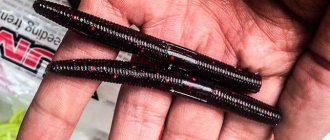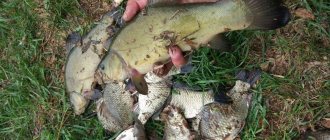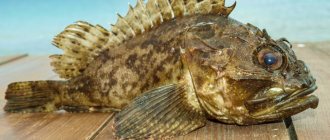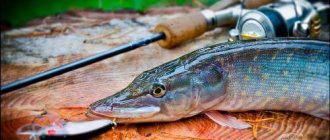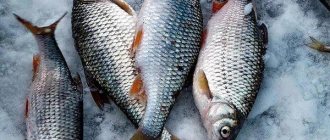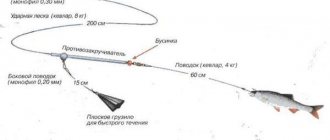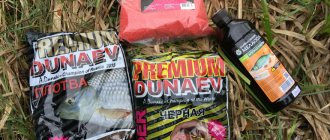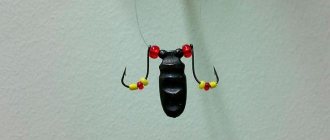A bottom overgrown with vegetation, abrasive sand, shell rock and stone, a hole filled with snags, muddy litter, branches and leaves that have fallen to the bottom are all favorite sites for predatory fish. But bad luck, getting it out of there with a regular jig is difficult, expensive and nerve-wracking.
In such difficult and at the same time promising places for fishing, it is important to use Carolina rig (Carolina rig, carolina rig), which refers to those types of spaced installation that will pass fire, water and copper pipes and is inexpensive, and even a beginner can install it . The Caroline is rightfully considered one of the most passable rigs.
In terms of cross-country ability, only the Texas rig can compete with the Carolina rig, but installation, conditions for optimal use, as well as the advantages and disadvantages of these equipment are different.
We can say that Carolina Rig = Texas Rig + leash.
Spaced rigs - you can clearly see the difference in the installation of the Carolina and Texas ones
There is no ideal bait and equipment for fishing, but there is one that is correctly selected for certain circumstances.
What does it look like (with photos and videos underwater) and what can the Carolina rig do?
Carolina rig is a subspecies of the classic Texas rig, but with some modifications that affect the features of using this type of rig, as well as the behavior and animation of the bait.
It is a spaced jig rig, where between the sliding sinker and the bait on the offset there is a fluorocarbon leader attached to the main braid through a swivel.
Texas and Carolina
What classic spaced-out rigs look like underwater - Tokio Rig, Texas Rig, CarolinaRig and a diverting leash:
Among the advantages of Carolina it is worth noting:
- Effective against passive fish , due to the fact that you can fish a promising water area with slow types of animation with long pauses and lazy dragging, practically forcing a generally unhungry predator to catch it because of its anger at uninvited guests - worms or fry.
- High permeability among stones, pebbles, shells, underwater vegetation and along sandy ridges . But for snags it is better to use Texas.
- Can be fished at any adequate depth . The size of the load does not in any way interfere with the predator’s bite. Due to the fact that it is sliding and distanced from the bait, the fish does not feel resistance when biting.
- From the previous point, the next one is that when using edible rubber, you can give the fish time to swallow the bait thoroughly - pause for a bite. This is possible because the predator does not sense the trick.
- Easy to install . A little more difficult than Texas, but still easier than other spacing.
What is a Carolina rig?
Carolina Rig is a variant of spaced rigging, when a leash with a hook and bait suspended on it acts as an extension of the main cord and is separated from it by a swivel, bead and weight.
It is a modernized version of the Texas equipment. Allows you to fish among aquatic vegetation and reeds without clinging to them. There is no special demand for a rod and reel. Only when fishing among snags should the spinning tackle be endowed with strength capable of overpowering the landing of predatory fish.
The main components of the equipment (see photo):
- Sinker. Americans use brass and bronze weights to catch the Carolina, due to the fact that when they hit the bead, they create loud signals that arouse the interest of underwater inhabitants. These metals are quite expensive, and our fishermen often use lead sinkers. The weight of the load depends on the fishing location, in particular the depth and power of the current.
- Bead. A particularly significant link in the Carolina equipment. Firstly, it acts as a damper that resists the knot on the hook being untied by the load. Also, when hitting the bead with a weight, vibrations occur, arousing curiosity in the predator. Using brass or glass beads would be the best option; plastic ones are also acceptable.
- Swivel. This element is the attachment area for the main cord and leash and blocks the cord from twisting during wiring.
- Leash. Monofilament or fluorocarbon fishing line is used. The second option has gained greater demand due to such qualities as: low stretch, wear resistance, and invisibility. The length is interconnected with the level of activity of the fish, approximately 30 cm - 1 m. The deeper the place and the larger the victim, the thicker the leash is needed.
- Hook. If the bottom is clean, then simple hooks or offset hooks are used, but the end of the hook is not closed. In areas with many hooks, an offset hook with a hidden sting in the body of the silicone bait would be a justified option. Its dimensions are dictated by the size of the bait and the mass of the planned victim.
- Main line. The main fishing line is almost always a braided cord. Sometimes monofilament is used.
About
Installation of Carolina rigging: which bullets and beads to choose, how to tie Carolina correctly
What is needed for making
To make it you will need spinning tackle (requirements for it are below). And also: weights of different weights, fluorocarbon in different unwindings, offset hooks, beads, swivels and a little knowledge.
How to choose a sinker
The weight for the Carolina rig is almost always a sliding bullet and only in the absence of one is an olive or an eared one.
According to the classics, foreign colleagues use bronze, brass, and tungsten as materials for bullets. They are louder when they hit a bead, which supposedly provides additional motivation for the fish to grab.
There is also an opinion that due to the fact that they do not dent, unlike lead, they get stuck less among stones, but this is a very controversial fact that has not been verified in practice. We found no such studies.
Our fishermen are not so rich and not such aesthetes, and therefore the good old lead is in favor.
The weight is selected exclusively in the same way as in classic jig fishing based on the depth of the reservoir, the strength of the current and the required casting distance.
Bronze bullets are very high quality and beautiful, but the price is steep - the price for a set is from 5 USD and above
By weight of bullets of the same size: brass (bronze plus minus)<lead<tungsten. Therefore, we would advise using tungsten in most cases, but only if there is such an opportunity.
How to choose a hook
In 99 percent of cases, an offset hook is used, since the Carolina hook is used in difficult conditions, and therefore there is no point in using regular hooks.
The size, height, shape is dictated by the baits used. You always need to have a set of offsets for different spinning conditions.
How to choose a bead(s)
Beads are needed to protect the nodal connections from the aggressive effects of a load sliding along the fluor. The bead should not splinter when hit by a bullet, and ideally, it should make a clicking noise when impacted by a weight.
Some colleagues consider the acoustic effect to be insignificant, or even far-fetched, but other experts, for example, the Shcherbakov brothers, have a different opinion and recommend using sounding beads made of brass and other sonorous materials in combination with a weight of the same composition.
How to choose a swivel
The swivel must first of all fit into the general outline of the tackle, that is, correspond to all its other parts. Don't be too small or too big. It is also important that it is of high quality and works well even on the slowest retrieves, otherwise twisting of the line cannot be avoided.
It is worth paying attention to the swivels on bearings!
How to choose the leash material, its length and thickness
Fishing takes place in an aggressive environment, therefore, for catching pike perch, perch and other predatory fish, in addition to pike, we use wear-resistant fluorocarbon; for catfish, flexible leader material is mandatory.
The length and thickness are selected based on the type and activity/passivity of the fish, as well as fishing conditions.
How to assemble the equipment installation
When installing the Carolina rig, it is important to take into account two nuances.
The first is that the leash should be made exclusively of fluorocarbon, due to the fact that you have to fish in difficult conditions, when the final part of the equipment is constantly exposed to the abrasive effects of sand, shells, stones, gravel, snags, etc. And it is fluor that is best suited for such conditions, while braid quickly becomes unusable.
The second is that the bullet-shaped sinker (or olive) constantly slides along the main fishing line, which also has an extremely bad effect on the cord, and this part of the equipment should also be fluor-based.
Option two:
- First. The main line is also fluorocarbon with a thicker diameter than the Carolina leader.
- Second. If braid is used as a base, then you need to tie up an additional part of fluorine, along which the weight will slide .
Classic Carolina rig
The first option is the classic one, when the weight is located on the main line.
Some fishermen do this installation with braid as a base, but we do not recommend it for the reasons stated above.
So, fluor 0.3-0.4 mm is used as a base. We pass a bullet-shaped sinker of the required weight with the nose to the tip of the rod.
Then we select the bead so that it fits “comfortably” into the recess of the bullet. We take a high-quality swivel that is commensurate with the entire equipment and tie it after the bead with one of the clinch, reverse clinch, double clinch, or palomar knots.
A fluor leash 0.05 mm thinner than the main one is tied to another part of the swivel through the same knot. That is, approximately 0.22-0.3 mm. The length of the leash is selected experimentally and depends on the activity of the fish, the speed of the current, the depth of fishing and the possibility of casting.
I have an opinion! Many hardcore spinning anglers recommend using a leash of at least 1 meter for Carolina spinning rods. Especially if the fish is extremely passive. There is a reason to listen, since the opinion is very widespread and is expressed by experienced athletes and simply practitioners.
In general, regarding the length of the leash, you should adhere to these not dogmas, but rules:
- the more passive the fish, the longer the leash and vice versa;
- the stronger the current speed, the longer the leash and vice versa;
- the deeper the water area, the longer the leash (and the larger the sinker);
- a long leash reduces the possibilities of casting, especially when fishing from overgrown banks, and this also needs to be taken into account.
An offset hook is tied to the second part of the leash and then the bait is attached.
Ready-made classic Carolina montage
Installation of a worm (driven twister) on an offset hook
We select the length of the offset hook according to the size of the bait, the width according to the type of silicone - the more propulsive it is, the lower the offset and, vice versa. It is important that the tip of the hook is hidden in the back of the bait, but at the same time, when biting, it is easily squeezed out.
Improved Carolina rig on a two-piece leader
This type of installation is used by avid and experienced spinning anglers if the main fishing line is braided.
In this case, we make two cuts of fluor, 50-60 cm each. We tie the two resulting sections to the swivel at different ends. Knots - clinch, palomar.
We put a bead on one segment, then a bullet, with a notch to the bead and another smaller bead on top. This part (pictured below on the right) will later be attached to the main cord through a knotless cord, a carrot knot, or through another swivel.
An offset hook is tied to the second part of the two-part leash and the bait is attached - everything is as in the method described above.
As a result, we get the following installation:
Caroline on a two-part leash
Two beads work as bumpers on both sides so that the knots do not break either to the swivel or to the knot that secures the main wattle and the leading part.
The weight slides along the flurry, the leash is of sufficient length.
The downside is that there are more fittings, which means there is a greater chance of breakage, plus it is not the best option for fishing in mud and snot algae, which tend to stick to all the equipment.
Mounting options for Carolina rigs when fishing for different predators
Carolina rigs for pike should contain a leader made of soft leader materials in the final part. Especially if the fishing for this predator is targeted. It is knitted in the same way, only at the end part a leash of up to 30-40 cm is placed from a soft one! (this is important) material.
Heavier weights and larger baits are also usually used, which is determined by the habits and places that the pike chooses for hunting.
When fishing for perch , especially passive ones, use the longest leashes of a meter or more. A diameter of 0.2-0.25 mm is almost always sufficient. Baits in 2-3 inches on appropriate hooks.
If the goal is pike perch , then when installing the Carolina equipment, it is worth taking into account the place in which the fishing will take place. In general, the leash used is shorter than for perch fishing, but thicker. Diameter 0.25-0.35 mm. The baits are also larger.
Making Carolina equipment step by step is clearly shown in the video:
“Karolinska” VS “Moskovskaya”. Or why I prefer one over the other.
We are all slowly learning and learning, so don’t judge my post too harshly, I’m not an expert or a professional, I’m a beginner amateur fisherman who started engaging in this fascinating hobby in 2013. I hope my review will save time and be useful to novice anglers.
And so Karolina and Moskovskaya (in common parlance a “diverter leash” - although in my opinion this is not quite the correct interpretation) are so similar and so different. The advantages of rigs have long been discussed and thousands of pages have been written, as well as the disadvantages, so I won’t repeat them - in my opinion, both rig options work equally well for active fish - on many fishing trips I didn’t notice much of a difference.
Let's start with where I use them most often on the Ob River: fishing from the shore, when you need to throw to the edge or pool, and the terrain does not allow the use of a jig, and fishing from a boat to depths of 2-3 meters with smooth depth changes ( in deeper places with sharp drops and drops, pros recommend using a jig).
Purpose of prey: perch, pike perch, less often pike and white fish.
And so let’s imagine ideal fishing conditions: good weather, feeding fish, i.e. we get an active bite - in this situation, you can use both types of equipment with equal success, I checked it from personal experience - about 10 successful fishing trips in the summer of 2013 in different places. More often I fished not far from the city of Novosibirsk (ObGES, Belye Rosy, at the dacha of Rybachy Island and Chaus).
But there are very few such successful fishing trips - “grabs” - in the season. More often than not, each of us, having found a little free time, passionate about our favorite activity - fishing, flies to the pond at the first opportunity - and no matter what the weather is outside, the fish has its own schedule and, arriving at the place, we understand that we have chosen the wrong the best time for fishing - but there is no other time - we will fish today!
And so, the spinning rod is assembled (let it be an average version with a test of 7-30, length 2.7, the action is not very important, the main thing is that it is not very coarse and not very noodley - in my opinion, the optimal coaster is medium-fast), we knit the popular Carolina rig , which your brother, friend and matchmaker caught well last weekend, we hook on a popular edible rubber, for example 1.5-2″ (given that the fish is passive, we choose the minimum size), cast and turn the reel with pauses, as we were advised, but there’s nothing …..we change the color, the size of the bait, the weight of the load, the length of the leash - the result is the same. I found myself in such a situation - I watched enough of modern programs, listened to enough advice from experienced fishermen, read articles from the Internet - I believed in the miracle of the Carolina rig and fished only with it, forgetting about the Moscow (diverter leash).
What to do you ask? I asked myself too. Then I thought, then I read and watched a video with the pros, I thought again and came to a conclusion: return to the classics, because in the current Carolina loses to Moscow 1 to 4. You ask: why? - after all, we are catching passive fish, in both rigging options the load drags along the bottom just like the bait, the casting range is approximately the same, but there are 2 “BUTs”, which will be discussed in more detail below.
1. “BUT” - The volume of the fished space - in the Carolina rig, the cord is pulled only towards itself (Figure 1), when the cord is etched towards the bait, the current will make an arc from the freed main cord, and even if the bait moves downstream, it will be insignificant.
In the Moscow rig, you can not only pull the reel or spinning rod towards you but also (Figure 2) but also back (Figure 3) until the leash with the bait is in line with the leash for the load, i.e. the length of the release cord should not be greater than the length of the load leash. Also, you shouldn’t release the line from the spool - suddenly there will be a bite, you can just work only with the rod blank. Accordingly, the fished bottom area is 2 times larger than that of Carolina.
The load is stationary in both cases.
Thus, having found a predator at a certain distance from the shore, you can fish 2 times more of the bottom where the predator is currently standing and, accordingly, get more bites.
2. “BUT” - Animation. The number of animation options for passive bait in the Moscow rig is greater than in the Caroline rig, which leads to an increase in the number of fish caught. The advantage is that you can do all this statically, i.e. while the load lies motionless. Your main assistant is the current - with its help you will excite even the most passive fish; you can animate even where there is no current, simply by twitching the spinning rod up and to the sides. For example, perch or pike perch stand along the grass, we fish from the shore, Carolina will not give you the opportunity to animate the bait in place, since the load will move towards you in any case, but in Moscow, on the contrary, you can bring the load to the edge of the grass or bushes and just shake from side to side giving the bait a playful action. Another plus is that in the Moscow rig you have 2 components - the length of the leader and the length of the leader for the load, by changing which you can choose the ideal option for your fishing conditions. For example, you need the bait to pass over the grass, then you increase the length of the lead for the sinker, or you are catching active fish on a clear bottom - reduce the length of the bait lead to 0.8-0.7 meters and the load, furrowing the bottom, will create a cloud of turbidity, which a predator sometimes loves. In the Carolina rig, we can only change the length of the bait's leader.
Try it, experiment. Good luck.
In what conditions is CarolinaRig installation especially good?
Carolina tackle is used when catching a passive and inhibited predator. In the middle latitudes of the CIS and the Russian Federation it performs well in early spring and summer, as well as throughout the year at points where it is necessary to fish the water area as slowly and accurately as possible.
For example, such places include holes and edges littered with debris when fishing for pike, riffles and places near them overgrown with grass and small algae when fishing for perch, gravel and rocky places where pike perch often hunt.
Due to the fact that this is a classic non-hooking with an emphasis on animation - dragging along the bottom, it works great in difficult conditions of an aggressive and overgrown bottom. Can be used among reeds, water lilies, on pebbles and sand.
Carolina rig: catching perch with a retractable leash
The leash in the Texas or Carolina rig is not in last place, so under no circumstances should it be thrown into the background.
It is worth paying attention to the length of the leader and the thickness of the leader line used. In my case, this is, as always, the irreplaceable fluorocarbon. The diameter depends on the fish and the conditions of use. Usually 0.16-0.18 millimeters is enough when it comes to catching small perch up to 1 kilogram.
When you are faced with the task of catching a perch within 1 kg. and higher, then a diameter of 0.2-0.22 is quite appropriate. The main line should be braided in any case. The braid is resistant to abrasion, has no memory, is not stretchable, and most importantly, due to its small size, it has a high breaking load.
Over the years of spinning fishing, I have tried a bunch of different options and, probably for the last 3 years, I have been fishing exclusively with pontoon 21 . The 8-strand braid has a slippery coating; when it passes through the rod's rings, it does not cause an unpleasant sound.
But that's not all, not everything is as simple as it seems. Pay due attention to the diameter of the fence. For example, for an ultralight, the cord diameter starts from 0.05 to 0.1.
With a cord, the bite is felt quite well and therefore the hook is hard and whipping, as required when catching small and medium-sized perch.
I don’t see any point in increasing the diameter, since even a 2-kilogram humpback whale is not able to tear off a braided line with a diameter of 0.2 millimeters. The braid should be wound to the very edge of the spool edge, only in this case the casts will be as comfortable and far as possible.
When the perch is active, feeding from the surface, chasing fry around the water area, you can use large diameter lines, but as soon as the perch’s mood goes to zero, problems with fishing immediately begin.
In this case, it makes sense to change your mind and leave the braided line in favor of a monofilament or nanofilament. Of course, nanofil is better, it has identical similarities with both braided and mono fishing line.
Ultimately, it is up to the angler to decide what to use, but the use of monofilament can only be avoided by using extremely thin braid, with a diameter of 0.04 millimeters.
Such cords are very expensive, their price fluctuates around 2000, and sometimes reaches 3000, well, how can you not sacrifice money for the sake of your favorite hobby: fishing!
Carolina Tooling: Making (HD Video)
What baits are used
For fishing with Carolina, worms, slugs, crustaceans, nymphs, vibrotails and twisters are used. Often - driven, as more passable and almost always edible.
Many fishermen prefer passive types of baits, due to the fact that the wiring technique involves constant impact on the bait with a rod and reel - dragging, tossing, light twitching...
It can be used as a regular sinking silicone, then it will drag along the bottom or jump, like a jig on a step, if the angler so desires. Or floating silicone, then it will float at some distance from the bottom (pelagic), animated following the actions of the spinning rod.
It is important that the bait is made of durable silicone - in the Carolinas the bait suffers a lot, especially its bow, which is often torn by the offset when a fish bites or hits rocks and snags.
Installation
Everything seems to be simple. Everyone knows what a drop shot is - at the end of the line there is a weight, and above that there is a hook. But, for example, I didn’t find any restrictions; is it possible to place the hook on a short leash? On the contrary, on YouTube they recommend doing this specifically for nano-dropshots! And I, having tried both the “classic” and the version with a leash, came to the conclusion that for catching leucorrhoea, a leash is necessary. But since it is SIGNIFICANTLY shorter than the outlet for the load, the “heel strike” for amateurs, that is, the feeling of a bite, has not gone away, and even, it seems to me, has not been blurred, unlike the other spaced-out equipment that was discussed here - the outlet leash.
Accordingly, my installation looks like this:
I usually tie it on a leader line. The outlet for the sinker is 25-40 cm, depending on the conditions and the horizon in which the fish is kept. I suspect that in other bodies of water this distance may also decrease or increase. Very roughly, we can give advice here that this size will also depend on the desired species composition and its typical behavior: for bottom fish (goby, crucian carp, perch) - less, for pelagic (bleak, roach, rudd) - more.
The leash is about 5-7 cm long. Why is it needed? As far as I understand, the suction power of the leucorrhoea bait is very small. And if there is no leash, then it is difficult for her to properly retract the hook along with the bait. When I fished with a “classic” drop-shot rig, the results of the leucorrhoea bites were very sad. A leash more or less solves this problem. In addition, from personal experience using this equipment, I was convinced that the leash also “softens” the wiring, and for catching non-predatory fish this is a very useful “side effect”
Sinker. Here is one of my “know-how”. Maybe I wasn’t the only one who thought of it, but then it “came to me” without any prompting!
To prevent the sinker from twisting the line, I put a sliding float olive, and below I knit a stop bead. This design of the sinker rotates freely around the fishing line, much easier than on a swivel. And besides, in the event of a break, the cost of the lost equipment does not include the cost of the swivel!
Although it can be even cheaper. Someone simply clamps the required number of float pellets onto the fishing line.
Regarding the weight of the sinker... Yes, I use 1 gram, and I call it “nano”. But the main idea of the “nano”, it seems to me, is the size of the bait and the smoothness of the presentation, and, accordingly, the less predatory species composition of the trophies. So, I suspect that there are conditions where even an ounce will be “nano”. For example, where there is great depth and a very powerful current.
How to fish with a Carolina rig: casting, retrieving technique, fishing on the river and in calm water
The Carolina rig is especially effective on reservoirs without current and in slow currents. It is in such conditions that Carolina shows itself at its best, allowing you to animate the bait as lazily as possible, dragging it along the bottom and playing along with the tip of the rod.
In holes and their entrances, on deep slopes, on edges, sharp and smooth changes in depth, you can work the bottom efficiently if you choose the right load. In such places, pike and large perch often lie in ambush behind underwater vegetation or snags.
For pike, the basic wiring of the Carolina fish works - uniform dragging with pauses and accelerations. Perch responds well to all sorts of tweaked animation motifs.
And, of course, when fishing for pike perch and perch on a rocky pebble bottom strewn with shell rock, the Carolina rig has no equal. Animation - uniform dragging along the bottom with pauses, a wavy step, uniform dragging with the tip of the form.
On a current, unlike a regular jig, a good result is achieved by casting across and into the current, so that the bait is dragged toward itself. The weight of the bullet is selected in such a way that when retrieving the bait, it will not be squeezed to the surface, but will go along the bottom.
It should be noted that in strong currents it will be more effective to use a diversion leash or texas.
Catching perch with a Carolina rig:
Features of fishing with a Carolina rig
This equipment has a number of undeniable advantages that allow it to be used in various conditions when fishing for perch, pike and pike perch with a spinning rod. The catch may also include other predatory (and even peaceful) fish.
Where and when to apply
The use of Carolina rigs is justified in certain conditions, for example in places with slow currents and varying depths. As for the fast current, fishing in such places is not effective enough.
The main feature of Carolina is the ability to use it in hard-to-reach places, mainly in thickets. Although it has less cross-country ability compared to the Texas, it does an excellent job of fishing in snags, stones or shell rocks thanks to the pointed shape of the sinker.
The catchability of the Carolina fish with passive fish is one of its important features, since the free movement and hovering of the bait in the water, combined with long pauses, makes it possible to provoke an inactive predator to attack. In addition, the free movement of the sinker along the line prevents the fish from feeling resistance at the moment of the bite.
This type of equipment allows you to fish both in shallow water and in the bottom layers of the reservoir. You can even get the bait to move a few centimeters above the bottom.
Catching pike with a Carolina rig
The peculiarity of fishing for pike in Carolina lies in the slow and wave-like movement of the bait, combined with short stops and twitches. In this case, the pike most often attacks while moving and shows almost no interest in a stationary bait, so it will not attack during a pause. To attract pike, you need to work harder with the tip of the spinning rod; this is especially effective when luring fish in a small current.
About
What gear is needed?
The gear is selected taking into account the fact that this is, albeit non-standard, but still jig fishing.
Form
This means that you need the most clear and responsive form, which reacts sensitively and transmits all the movements of the fisherman towards the bait and all the movements of the bait and fish bites in the opposite direction. Build - fast. The test is selected based on standard fishing conditions in your region. In most cases, two forms are enough to cover the entire test range. 2-15 and 5-30 grams. For those who fish in large reservoirs and rivers, a more powerful blank with a dough weight of up to 60 grams and higher is needed.
The length is selected according to anatomical data and fishing conditions. Station wagon 2.4-2.7 meters.
Reel and cord
If braid is used as a base, we recommend using a 2000-2500 Shimano spinning reel with high-quality cord laying and without dropping loops on aggressive types of animation. The diameter of the main braid is 0.12-0.18 mm.
If the basis is flurry, then only a multiplier. Meat grinders with thin fluor diameters (and most often used with a diameter of 0.22-0.35) work mediocrely, loops often overlap and drop off.
Beautiful Carolina rig - is it a panacea? Not really. Number one choice for jiggers? No again. Carolina is only a tool that, in skillful and understanding hands, under certain conditions, can come to the fore, leaving behind the classic jig, lead-eared rigs and other methods with which spinning anglers try to deceive an increasingly sophisticated predator.
What to use to catch perch?
Catching perch on a retractable leash is quite popular with a silicone worm, twister and vibrotail. These are universal baits that do not require super animation, they play well and attract picky perch, and that’s all an angler needs.
Previously, when I caught perch on a microjig without using a retractable leader, the catches were much smaller. I learned about these 2 methods in some fishing magazine, in my opinion, “fish with us.”
Without thinking twice, I went, bought the missing parts for the equipment and went to a pond infested with perch. At first everything was not so great, I didn’t understand basic things, but then the first bite happened and I became more interested.
On each subsequent fishing trip I began to experiment. The experiments were reminiscent of the random method, the trial and error method. The point was that I wanted to understand what size twister or vibrotail the perch bites better with.
Until now, I still have not received an answer to my own question. The thing is that when I put a 2-inch bait, a perch of the appropriate size bites. A small perch is not able to swallow a 4-centimeter bait, but a medium-sized perch, on the contrary.
If I set the twister smaller, then a standard small perch was caught, but the large striper completely lost interest in the bait. And finally, I realized that the length, width and even weight of the bait plays a very important role when catching perch.
On the river it is worth fishing with 2 and 3 inch baits when it comes to microjig and ultralight. On a pond, 1-2 inches is the norm, since the perch there is much smaller.
Another aspect of this type of fishing that should not be overlooked is the color of the bait. In dark weather, bright, provocative colors from poisonous acid to bright red show themselves well. In sunny weather, on the contrary, you should take a lure of machine oil or something like that.

